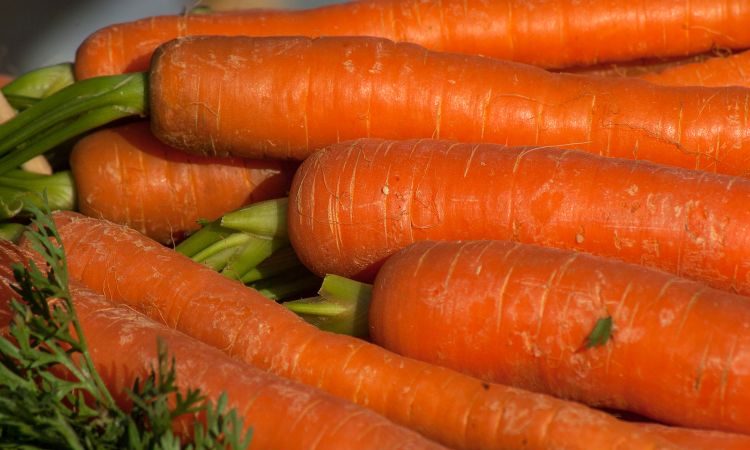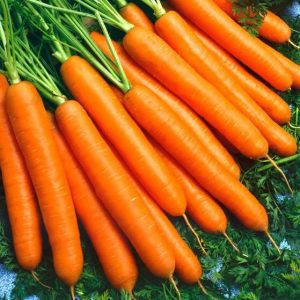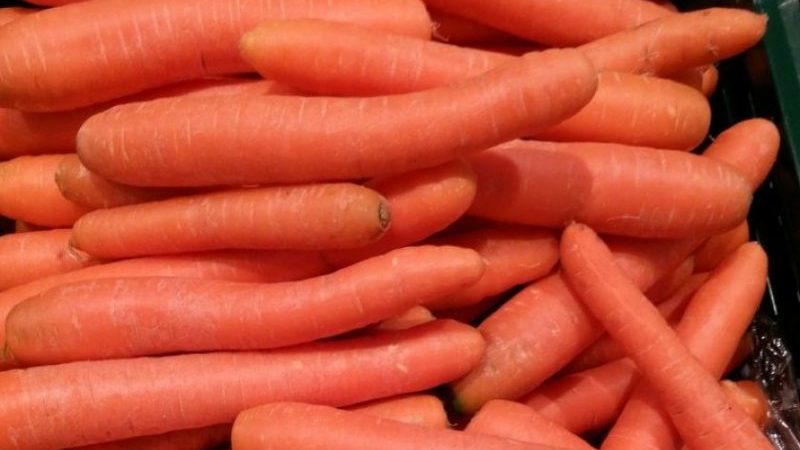High-yielding hybrid of carrots Sankina lyubov
Among the hybrids of Sankin's carrots, love is distinguished by unpretentiousness to the soil composition and climatic conditions. Even in rainy, cool summers and when grown in heavy soil, gardeners get a rich harvest of even, long root crops with excellent taste.
The content of the article
Description of the hybrid
The culture is late maturing, root crops are suitable for long-term storage. Sweet vegetables are rich in carotene, therefore they are valuable for baby and medical nutrition.

Origin and development
Sankin love carrots were bred by breeders of the Moscow agricultural firm "Uralsky Dachnik" for cultivation in regions of risky farming, including the Urals and Siberia. Vegetable growers cultivate a hybrid throughout Russia.
Sankin was not included in the State Register of the Russian Federation.
Composition and useful properties
Root crops contain macro- and microelements important for humans:
| Name of substance | Content in 100 g of product | Beneficial features |
| Potassium | 320 mg | It is necessary for intracellular metabolism and normalization of water balance. |
| Sodium | 69 mg | Together with potassium, it maintains acid-base and water balance, it is necessary for muscle contractions. |
| Phosphorus | 35 mg | It is important for bones, teeth, muscles, heart and kidneys. Participates in energy metabolism and transmission of nerve impulses. |
| Calcium | 33 mg | Forms the basis of bones and teeth. Participates in the conduction of neuromuscular impulses, regulates hormonal activity. |
| Magnesium | 12 mg | Stimulates the digestive system, supports the work of the heart, muscles, nervous system. Has vasodilating properties. |
| Manganese | 0.1 mg | Important for the immune and reproductive systems. Participates in neurochemical processes. |
| Aluminum | 320 mcg | Forms tissues of the musculoskeletal system and skin in combination with other trace elements. |
The main value of the hybrid is the increased content of carotene in roots: up to 9 mg per 100 g. Once in the body, it is converted into vitamin A, which is especially important for the growth of the child's body. Beta-carotene has antioxidant properties.
Interesting! In ancient Rome, carrots were considered a sacred plant: they are both a crunchy treat and a natural medicine. Root vegetables contain carotenoids, vitamins, carbohydrates, essential oils, mineral salts.
Vitamin composition of carrots:
| Name | Content in 100 g of product | Beneficial features |
| B vitamins: thiamine, riboflavin, pantothenic acid, pyridoxine, folic acid | 30 mg | They support the immune system, normalize the work of the cardiovascular and nervous systems. Improves skin condition, bowel function. Protect the body from stress, prevent muscle cramps. |
| Vitamin C | 5.1 mg | Strong antioxidant. Fights inflammatory processes, strengthens the immune system. |
| Vitamin E | 0.6 mg | Supports the reproductive system, participates in metabolic processes. |
Ripening period and yield
Sankin's love is a late-ripening carrot. Root crops reach biological maturity in 120–135 days from the moment of mass emergence.
A high-yielding hybrid: 5 kg of carrots are dug out from 1 m2.At the same time, high productivity is ensured even on clay soils.
Disease resistance
With excessive watering, stagnation of water in the soil and thickening of the plantings, the hybrid is susceptible to fungal diseases:
- white rot;
- black scab;
- brown spot;
- dry and black rot.
Diseases manifest themselves when growing crops and storing crops.
Important! The guarantee of healthy root crops is liming the soil before sowing.
Specifications

Sankina love is a cold-resistant hybrid that is not demanding on the soil. Root crops do not break or crack.
They have an attractive presentation: the tip is dull, the core is not expressed, the shape is cylindrical, the length is 20-25 cm, the width is 3 cm, the color is bright orange, the skin is thin. The mass of vegetables is 90–120 g. Juicy crunchy sweet root vegetables are universal in use.
The plant does not shoot and does not bloom. Carrots do not lose their taste until spring. It is planted both before winter and in spring.
Growing regions
A hardy hybrid is in demand throughout Russia. It is suitable for growing both in the middle lane and in the cold regions of the Urals and Siberia. There are no special requirements for the climate.
Advantages and disadvantages
Hybrid advantages:
- high productivity;
- large root crops that are not prone to cracking;
- undemanding to soil and climate;
- lack of tendency to flowering and shooting;
- good keeping quality of the crop;
- increased carotene content;
- excellent taste of carrots (on a five-point scale, the highest);
- versatility in cooking;
- the possibility of inclusion in children's and therapeutic diets.
The main disadvantage is susceptibility to fungal diseases and pest attacks.
Differences from other varieties
The peculiarity of the hybrid is to obtain a high-quality harvest even on heavy soils. The roots themselves are stored for up to 10 months without losing their presentation and taste. The high content of sugar and carotene makes vegetables indispensable for baby food.

Features of planting and growing
Sankin love carrots are planted both in autumn and spring. Winter sowing in late October or early November allows you to get an earlier harvest for quick use, and the crop is planted for winter laying in the spring.
Preparing for landing
The seeds of the hybrid do not require pre-sowing treatment. Dry grains are laid in the ground both for winter and spring sowing.
The garden bed is prepared in the fall: it is cleaned of plant residues, dug up. The composition of the soil will be better if you sow green manure in the fall, and dig up the soil again in the spring.
Ground requirements
The ideal soil for carrots is loam or sandy loam. Clay soil, if desired, is fertilized with a mixture of peat and sand at the rate of 10 liters per 1 m2.
Important! Fresh organic fertilizers are not applied for planting, otherwise the root crops will be deformed.
Predecessors
The vegetable is grown in the area where it was previously grown:
After dill, parsley, celery, zucchini and other varieties of carrots, the culture is not planted in order to avoid possible diseases.
Timing, scheme and landing rules
Sowing in spring is carried out in late April - early May, in autumn - in late October - early November. In the northern regions, carrots are planted 1-2 weeks later.
The row spacing is 20 cm. The grooves are dug 1.5–2 cm deep, and watered abundantly. Then the seeds are laid out and sprinkled with earth. To preserve moisture, the bed is covered with transparent plastic wrap.
Reference. Some gardeners compact the plantings with their hands so that the seeds are not blown out in strong winds.
Growing features
Sankin's love needs certain conditions, which are created at the stage of choosing a suitable place. A sunny, open area is suitable for carrots, with onions and garlic next to it. These crops repel pests. The surface of the beds is leveled, they provide good drainage so that excess liquid does not accumulate.
After the first shoots appear, the film is removed after 2-3 weeks. Carrot care consists of regular watering, loosening, weeding, feeding and pest control.
Watering mode
Carrots are a moisture-loving plant. Irrigate it every 2-3 days. While the sprouts are small, the watering intensity is low. As the root crops grow, the amount of water is increased so that the earth is saturated with moisture to a depth of 15–20 cm.
To improve the taste of vegetables, increase the sugar level in them and extend the shelf life, watering is stopped one month before harvest.
Attention! When watering, use only warm settled water.
Thinning and weed control
To obtain large and even root crops, carrots are thinned 2-3 times per season. When the height of the tops reaches 4–6 cm, remove excess seedlings, leaving 3-4 cm between the plants. The procedure requires care and accuracy. Experienced gardeners use tweezers. Re-thinning is carried out a month after the first, removing excess plants and increasing the distance between them to 5–8 cm.
Weeds - a source of unwanted microorganisms that take nutrients from the crop - are removed from the ground as they emerge.
Top dressing
Sankin's love does not require frequent feeding. A month after the emergence of seedlings, it is enough to add minerals containing nitrogen, potassium and phosphorus. The classic version of such an additive is Nitrofoska, diluted at a concentration of 1 tbsp. l per 10 l of water.
2.5 months after the emergence of seedlings, the planting is watered with a solution of wood ash (1 tbsp. Dry matter per 10 liters of water).
Disease and pest control
Fungal diseases at an early stage are treated with biological drugs: "Fitosporin", "Phytodoctor", "Trichodermin". At a later stage, the affected plants are removed, and the rest are sprayed every 2 weeks with the fungicide "Cuproxat" until the signs of the disease are completely eliminated.
The main damage to carrots is caused by pests:
- carrot fly;
- wireworm;
- slug;
- bear;
- aphid;
- scoop.
In the fight against them, insecticides are used: "Inta-Vir", "Fas", "Mukhoed".
Important! Avoiding stagnation of water in the soil and timely weeding is the best prevention of plant damage.
Growing difficulties and recommendations
There are few difficulties in cultivating a hybrid:
- laboriousness of carrot thinning, especially when shoots appear;
- fight against fungal diseases and pests.
Tips from experienced vegetable growers:
- To protect the plantings from carrot flies, marigolds and calendula are planted around the perimeter of the beds.
- Root crops are stored until spring without loss, if they are first dipped in a clay mash and dried.
- If young carrots are periodically plucked for direct consumption, the remaining vegetables will have more room to grow.
Harvesting and storage

Timely harvest is a guarantee of its long-term preservation.
How and when to collect
Harvesting begins 120–135 days after germination. If white roots have formed on the tips of the root vegetables, and the tops have turned yellow at the base, then the vegetables are ready for harvesting. A dry warm day is chosen to dig them out.
Harvesting is completed by mid-September, before the rainy season.
It is better to dig up carrots with a shovel, not with a pitchfork. After being removed from the ground, the vegetables are cleaned of soil residues and the tops are cut at a height of 2 cm from the base. Completely healthy and whole roots with a dense structure are selected for laying.
Features of storage and keeping quality of the hybrid
Before storage, carrots are dried for 24 hours in a dark place. Then they are placed in wooden boxes in layers, sprinkled with a layer of sand of 2-3 cm. They are kept in a cellar or basement at a temperature of + 2 ... + 4 ° C and an air humidity of up to 98%.
If the correct storage conditions are observed, vegetables will last until next spring and even summer.
Reviews
Gardeners speak out positively about the hybrid, noting its resistance to weather conditions, immunity to diseases, subject to the rules of agricultural technology and a sweet taste.
Margarita, St. Petersburg: «For the fifth year now I have been growing Sankina love because of the sweet and juicy taste of root vegetables. Grandchildren crunch with pleasure. The fruits are even, they have never cracked or got sick. Even a rainy summer did not affect the harvest. "
Olga, Sysert: “The hybrid is good, there are no problems with growing and storage. I use mineral fertilizers, I water it infrequently. I thin out 2-3 times over the summer. I'm happy with the harvest, I recommend it to everyone. "
Conclusion
Hybrid Sankin love is not picky about the climate and soil, gives a rich harvest of juicy sugary root crops. Due to the high content of carotene, vegetables are suitable for baby and medical nutrition. The harvest is stored until the next season.